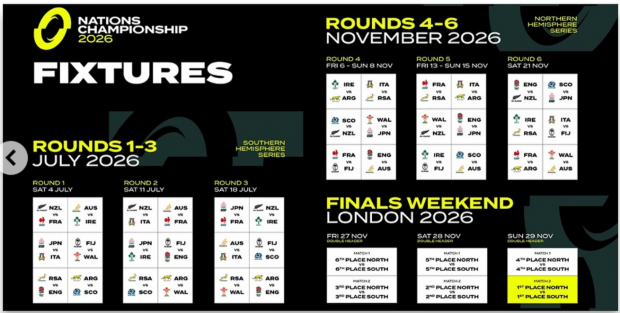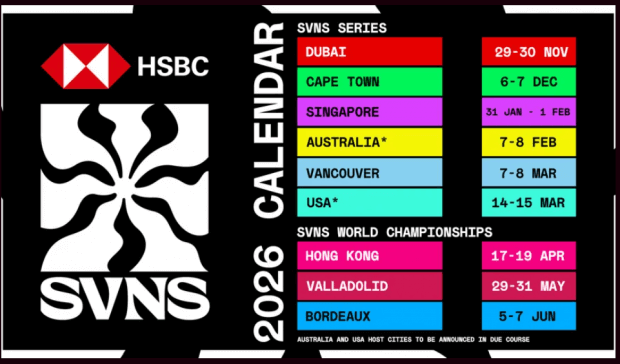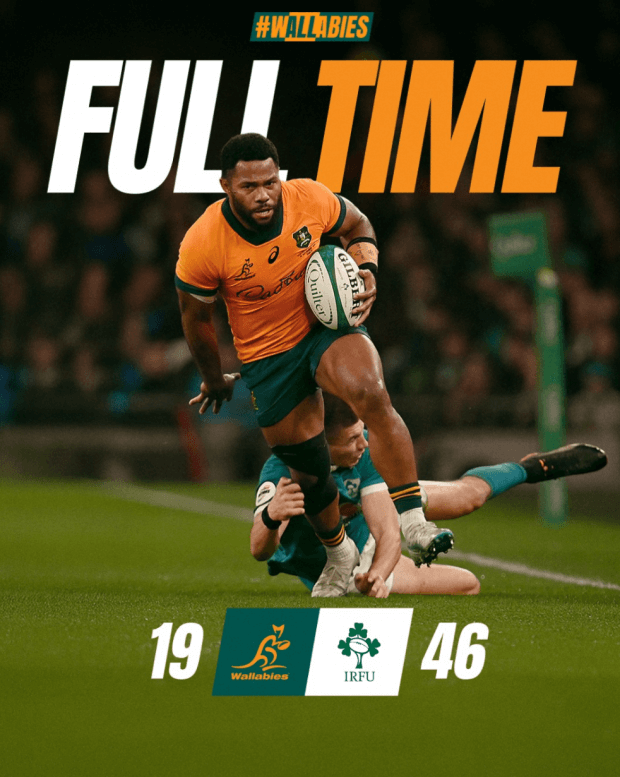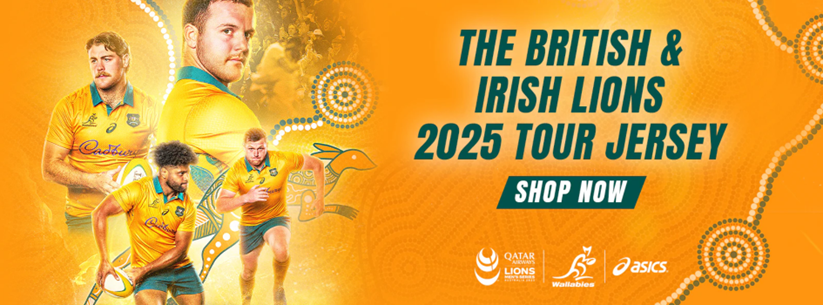18 November 2025
Good morning team, and welcome to Tuesday’s news. It was a tough weekend at the end of a tough three weeks of results for Wallabies fans; maybe the silver lining is that there’s only one game left this year before the players and us fans can have some time off, enjoy some other interests, recharge for the festive season, and then get back into it for Super Rugby next year.
If you’re still looking for more rugby to watch after this week, the Sevens season kicks off in Dubai on the weekend of 29-30 November and, hopefully, the Aussies Sevens teams will start their seasons better than the Wallabies are finishing theirs.
Nations Championship launches

Karl talked about it yesterday with the myth of the southern hemisphere being superior to the north being busted on the weekend. 2026 will see a chance for hemispheres to battle it out and establish bragging rights.
World Rugby has launched the Nations Championship with details of the 2026 released today and covered by Nathan Williamson on rugby.com.au here. The Nations Championship will include 12 teams, two blocks of games in July and November, culminating in a finals week on the last weekend of November. Next year will see Australia, New Zealand, South Africa, Argentina, Fiji and Japan from the southern hemisphere take on England, Scotland, Italy, Wales, France and Ireland.
The following is an explanation of the Nations Champions from Nathan’s article:
- The Nations Championship is a new international rugby tournament that transforms the existing July and November windows into a competitive cross hemisphere format every two years, outside of a Rugby World Cup and Lions tour year.
- Features 12 of the strongest nations in rugby with two groups of six teams. The Six Nations teams will form a European group representing the Northern Hemisphere, and take on the SANZAAR nations, plus Japan and Fiji, who form a group nominally representing the Southern Hemisphere.
- Next July, the Northern Hemisphere group of teams will travel to play three rounds of fixtures, with every team playing a different rival from the opposing Hemisphere group.
- In November next year, the Southern Hemisphere group will travel north for the remaining three rounds.
- Points are on offer across the July and November windows, to then dictate the table standings per hemisphere group and inform the schedule of fixtures for the Nations Championship Finals Weekend at Allianz Stadium in London.
- The Finals Weekend will see the No.1 ranked team in the Northern Hemisphere group play the No.1 ranked team in the Southern Hemisphere group in the final to decide the inaugural Nations Championship winner.
Australia will play:
- Ireland on the first weekend, 4 July
- France on 11 July
- Italy on 18 July
- England on the first weekend in November (6-8)
- Scotland 13-15 November
- Wales 21 November
The full set of games are shown in this image below.

The teams will accumulate points and be ranked from 1st to 6th place for each hemisphere.
Then on the last weekend of November, the north and south will play off with:
- Sixth place north v sixth place south
- Third place north v third place south
- Fifth place north v fifth place south
- Second place north v second place south
- Fourth place north v fourth place south
- First place north v fourth place south.
I think the competition sounds like a great idea, at the least it will have Fiji and Japan against each of the northern hemisphere teams and should help to bring on their development. You could say the same thing about the Wallabies maybe…
I’m backing a South Africa v France final for first place, and a New Zealand v England for second place.
Sevens Rugby

The Sevens series gets going in Dubai on the last weekend in November when a lot of the women’s teams, including Australia, will welcome back Rugby World Cup stars. The competition has been abbreviated compared to recent years with six regular season rounds, and three world championship rounds in April, May and June.
It makes sense the series has been rationalised and a longer finals series introduced to give the season more meaning. Anyways, it’s fun to watch, and hopefully the Aussies can get stuck in quickly and can win some silverware.

Wallabies player ratings

As usual, in the week after a Wallabies test we’ll do player ratings. These are my ratings based on watching the game on Sunday and rewatching the ball in play replay on Monday night. There was obviously some commentary on the match review on Sunday, and in the Monday news which I’ve taken into account. As always, we’re using the G&GR scoring system:
10 – A legendary performance to go down in the history books
9 – Outstanding performance: Man of the Match shoo-in
8 – Excellent all-round game
7 – Good game with a few sparkles
6 – Solid performance
5 – Average – a pass mark
4 – Below par
3 – Had a bad game
2 – Tell your story walking pal
1 – A complete joke
0 – Didn’t make it on, or no meaningful involvement.
- Angus Bell – Bell, Faessler and 7As have to take responsibility for the early short arm scrum penalties, otherwise Angus did what he does and put his hand up for carries. 4
- Matt Faessler – Our lineout was all over the place throughout the game, it might’ve been the lack of regular jumpers, but the throwing was also off the mark it seems. 4.
- Allan Alaalatoa – Allan worked hard around the field. 4.
- Jeremy Williams – Was part of a misfiring lineout and was on the wrong end of a mismatch with Prendergast running around him to set up an early game opportunity. 4
- Tom Hooper -One of Australia’s best with plenty of carries, tackles and working hard off the ball. But, was part of the lineout woes, maybe his best role is on the side of the scrum. 5
- Rob Valetini – Working his way back into form with some good carries and tackles. 5
- Fraser McReight – Scored a try, was busy on and off the ball, often fills in at halfback when Gordon was elsewhere. 5
- Harry Wilson- Got to put his rugby skills on display few times with a break out run and a dummy and go close to the line. As the captain, probably had to do more to keep the team in the game. 4
- Jake Gordon – As the distributor in close Jake chose who to pass to, others have commented his passing was too slow and poorly directed. Did run once or twice on the weekend, but couldn’t break the Irish line. 4
- James O’Connor – JOC got thrown into the game after the Italian loss and couldn’t do enough to keep Australia in the game. Did trigger some good Aussie play but, was also guilty of spilling high balls and not changing the picture in attack. 4
- Harry Potter – A great tackle to hold up an Irish player and save a try and was generally pretty busy. Struggled to defuse the high balls and have a positive impact. 3
- Len Ikitau – Scored the Aussies’ first try but was otherwise well contained by the Irish throughout the game. 4
- Joseph-Akuso Suaalii – Had some decent early touches, and some good defence. but isn’t finding a way to get involved with the high balls in attack or defence. 4.
- Filipo Daugunu – Put on some good early tackles, but as with the rest of the Wallabies back three, was unable to stem the flow of possession that Ireland got from high ball turnovers. 4
- Max Jorgensen – A forgettable night for the Wallabies fullback. Wasn’t able to win the high ball challenges which led to turnovers and lost possession. 3
- Billy Pollard – Scored a try, but also missed lineout throws and the scrum was unsteady when he was on the field, and as with the rest of the team, couldn’t stop the Irish running riot in the last 15 minutes. 4
- Tom Robertson – On at 53 minutes, but was part of a front row that couldn’t dominate, and a bench that couldn’t lift the Australian team. 4
- Zane Nonggorr – On at 60 minutes but limited opportunities to impact the game. Part of the bench that couldn’t lift. 4
- Nick Frost – Brought on halfway through the second half, but couldn’t rectify the lineout woes, and copped a yellow card for a high tackle off the ball. 3.
- Carlo Tizzano – Carlo was on at 62 minutes, was busy, with hit ups and tackles, but Ireland ran away with it at the end. 4
- Ryan Lonergan – Got 10 minutes at the end of the game. Very limited opportunity on attack. Don’t remember any errors. 4
- Tane Edmed – Replaced JOC with 10 minutes to go, but it was all going in favour of the Irish in that time. Was part of a bench that couldn’t change the flow of the game. 4
- Andrew Kellaway – On at 58 minutes to replace Daugunu. Couldn’t spark the attack, and didn’t improve high ball retention. 4
I had a couple of schools of thought in these ratings. We were in the game for about 50 minutes (at least on the scoreboard), but we were never dominant, or in control, and Ireland made their share of errors (dropped balls, missed passes). Then the reserves took the field and Ireland found two extra gears. You could blame the bench alone, but there were still plenty of starting players on the field for from 50 to 70 minutes, and collectively, we let Ireland control the game and take it away from us.
Ireland were good, we weren’t across the field. I might be a bit harsh on some of the forwards, but we did lose by a record margin at the end.
That’s a wrap
As always, thanks for making it this far, look forward to the comments section.


